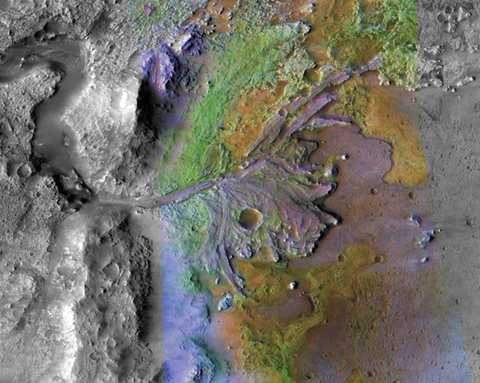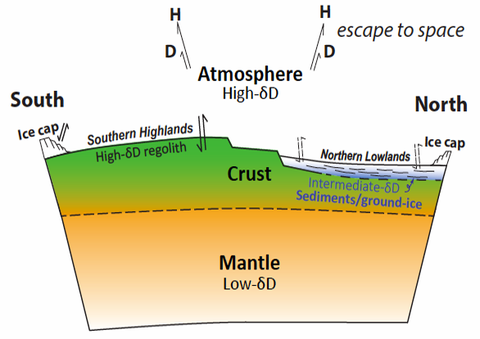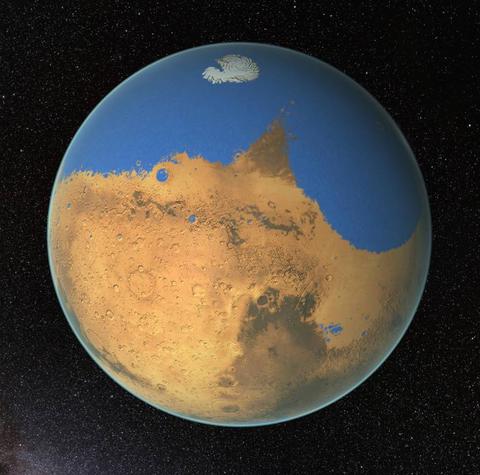Research Highlights
The Unfolding Story of Water on Early Mars, and What It Says About Life
By Marc Kaufman
Tomohiro Usui of the Earth-Life Science Institute. He started his new position as a tenured professor at the Japan Aerospace Exploration Agency (JAXA) as of July 1, 2018. His recent work has focused on the amount of water there once was - and still is in the form of subsurface ice - on Mars (Credit: Nerissa Escanlar)
The study of the origins of Earth and life on it - how geoscience became bioscience - used to focus exclusively on our planet. That is no longer the case.
NASA and other missions to Mars and potentially habitable moons of Jupiter and Saturn, as well as the explosion of knowledge about planets outside our solar system, have broaden the origin of life field ever further. Now, the origins story has gone extraterrestrial, and an origins institute has to go extraterrestrial as well.
At the Earth-Life Science Institute (ELSI) at Tokyo Tech, this is apparent in the focus on planet formation and the oceans molten rock on terrestrial planets in their earliest stages. But it now also includes research on the habitability of early Mars and how to read the atmospheres of exoplanets.
ELSI's contribution to early Mars research centers on water, and the key and much-debated question of how much of it might have been present and free-flowing on the surface 3 to 4 billion years ago.
ELSI associate principal investigator Tomohiro Usui, an expert in geo and cosmo chemistry, has been working for several years on the question of how much water was present on early Mars.
Now bone dry, the issue has been addressed by Usui and colleagues at NASA and elsewhere by studying isotopic signatures of hydrogen and its heavier form, deuterium, in Mars meteorites.
A color-enhanced image of the delta in Jezero Crater on Mars, which once held a lake. Over the past decade the scientific consensus regarding the amount of water on early Mars has increased substantially. This increase, based on observed fossil deltas and rivers as well as the presence of minerals that can only be formed in water, has major implications for the possibility of life having emerged on early Mars. Scientists still struggle, however, to model a climate that would allow for so much free-flowing water. (Credit: NASA/JPL/JHUAPL/MSSS/Brown University.)
Their conclusion: Mars once had a great deal of water, and a substantial amount of it - as much as 90 percent -- remains frozen below the surface rather than having been split and swept away as the protective atmosphere of Mars disappeared.
That subsurface water reservoir consists of much of the substantial amounts of water initially present on Mars, he said. "Given our data, that had to be the case."
The ELSI effort to understand water on early Mars has been expanded with the recent arrival of research scientist Ramses Ramirez.
A climate modeler specializing in early Mars, he has been actively involved in research that could help resolve one of the most hotly debated issues in early Mars study: the inability to come up with a
broadly-accepted climate model that would allow for a warm and wet early Mars.
Ramses Ramirez is a climate modeler and research scientist at ELSI. His work as a postdoc at Cornell and at ELSI has focused on Mars and how planetary atmospheres with abundant hydrogen could make the habitable zones of some extrasolar planets significantly larger. (Credit: Cornell University)
Most recently, the science lead of the Curiosity mission, Ashwin Vasavada, said there may well have been water at the rover's landing and research site of Gale Crater for up to a billion years - much long than previously imagined.
Clearly, the models and the evidence coming back from Mars are seriously out of alignment.
Ramirez, formerly a postdoc at Cornell University, has spent years trying to come up with a solution, and he is convinced he has it.
He says that the release of vast quantities of hydrogen during volcanic eruptions on early Mars (and early Earth, too) could have created a greenhouse effect far different from the carbon dioxide and methane-induced greenhouses most modelers invoke.
The greenhouse that Ramirez puts forward also requires CO2, but the presence of the hydrogen allows for a more powerful and long-lived greenhouse effect - especially if there was a lot of water on the surface.
"Most of the current models are simply wrong," Ramirez said.
"The modelers are not grasping the reality of what has been found on Mars. As I see it, the problem is a set of incorrect initial assumptions that led to incorrect physics and chemistry."
A key factor in his thinking, Ramirez said, is the work of Usui that supports the presence of large amounts of surface water on early Mars. If very large reservoirs of water ice remain below the surface of the planet now, it's only logical to assume that large amounts of surface water were present on early Mars.
Both Usui and Ramirez were familiar with each other's work, and so a collaboration developed soon after Ramirez arrived in Tokyo.
Based on an analysis of hydrogen isotopes in Mars meteorites, Usui and his colleagues concluded that the planet has a significant reservoir of water ice below its surface. They were the first to find a ratio of those isotopes distinct from that found in water in the Martian mantle and current atmosphere. Isotopes are atoms of the same element with differing numbers of neutrons. (Credit: NASA)
"We hope to reconcile the climate modeling with the water inventory on early Mars, as described by Usui and geology and geochemistry found on the planet," Ramirez said. "We'll be able to feed off one another on questions like how much water was there and how long did it remain on the surface. We're both interested in the same problem."
ELSI vice-director John Hernlund called the two "tops in their fields" and said he believed their collaboration will produce important results.
Underlying their work is the conviction that studying the possible emergence of life on other planets is now part of the pathway forward to understanding origins of life on Earth.
This assumption flows naturally from knowledge that early Earth had an atmosphere and surface quite unlike ours today, and possibly more similar to the conditions on some other distant exoplanets.
So clues to how life began on Earth may ultimately lie on other planets much closer to their own initial period of formation. Or perhaps on planets where everything about their worlds hasn't been dramatically altered by the presence of a vast biosphere, as it has on Earth.
Mars would fit into that second category. If there was life on early Mars, it is highly unlikely that it evolved far or spread wide before the planet's protective atmosphere began to be stripped away. The result is that the geological, hydrological and geochemical remnants of early Mars could provide a model of sorts for what Earth was like when life began here.
Liquid water is so important because it is viewed as essential to life on Earth and, by inference, most likely essential to life elsewhere because it is such an ideal solvent. A step further, a discovery that any distinct form of life once existed on Mars (or any other body) would strongly imply that life had originated innumerable places in the cosmos.
Ramirez said that the debate over water on Mars has taken a most interesting turn of late towards a theory that was considered highly unlikely a few short years ago. That theory involves the possible existence long ago of a "northern ocean" in the northern lowlands of Mars.
That area is one to two miles below the ground level of the southern highlands, and the sharp drops have never been fully explained.
While some see it as evidence of a long-ago large meteorite hit, others say the northern lowlands show many signs of having been formed by, or filled by, a large ocean.
From evidence on today's Mars surface, the Northern Plains is considered a likely candidate to have been the location of an ancient ocean" (Credit: NASA/GSFC)
Ramirez was recently at an early Mars conference and he said a possible northern ocean was very much on the agenda to explain the drop, described as "the dichotomy."
"The case for a northern ocean on Mars has never been as strong as now," he said. "I heard lots of support for the hypothesis."
The support comes most prominently from those who say the discoveries of fossil lakes and rivers of the past decade make it almost necessary that a very large body of water that was at the center of a Martian hydrologic cycle. The Earth's rivers and lakes need oceans to supply atmospheric H2O that will condense, rain and then evaporate again. It seems logical now to posit a similar cycle on Mars.
What's more, two recent papers have reported signs of the remains of massive tsunamis near what would have been a shoreline. The absence of a identifiable shoreline has long been seen as a weakness in the northern ocean theory, and the tsunami remains - if confirmed - could explain why a shoreline is not visible. Based on climate models and more, Ramirez views the long-ago existence of a northern ocean on Mars as quite likely. Did geo-chemist Usui share that view based on his work on the Martian water budget?
His reply was that it is surely possible. Whether it was a long-lasting ocean or a more transient large lake remained uncertain, he
said with customary scientific caution.
But asked if he agrees with the conclusion of Ramirez and others that the discovery of last-lasting lakes and rivers on Mars required a hydrologic system with a large body of water, his reply was "Yes, I totally agree with him."

















